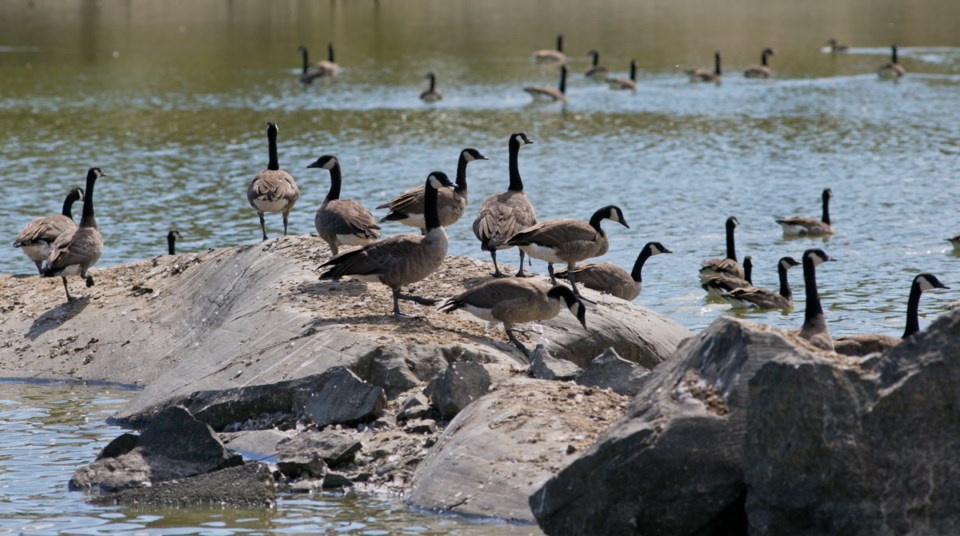A Capital Regional District working group is talking about a cull to get rid of some of the honking big Canada geese population. That’s if the group decides it’s the only way to curb proliferation of the birds and Environment Canada can be convinced of that.
Goose-related crop damage, water pollution and feces on public and private green space have posed problems for years, but April 2014 is the earliest that any new tactics can be tried, such as stepped-up addling when the eggs have been laid, said the CRD’s Mike Waters.
“If we’re not ready by then, we wouldn’t be able to move forward,” said Waters, co-ordinator of CRD’s goose-management strategy working group. The region is mulling a region-wide addling permit to save farmers and organizations the trouble of filing separate applications to Environment Canada. A cull would not likely take place before 2015, Waters said Monday.
“We’re talking about [a cull] as a steering committee, but we haven’t decided to do it,” Waters said. “We’re exploring whether it’s a viable option, and we’re taking direction from the experts, and that’s certainly the Environment Canada biologist.”
Ottawa has strict protocols to protect the minority of local geese classed as migratory, Waters said. The management strategy gets sticky when about 1,000 geese are migratory and thus protected by Ottawa, but only avian experts can tell which is which, Waters said. That rules out any notion of a goose hunt. If it comes to a cull, some non-migratory geese would be rounded up and euthanized with gas.
An estimated 6,000 geese are blamed for $300,000 worth of damage to local crops along with much mess, some of which is blamed for warnings against swimming in Glen Lake earlier this summer.
Environment Canada spokesman Mark Johnson cited Nackawic, N.B., as having received a kill permit in 2011 for as many as 250 geese during moulting season when they could not fly. “Our records indicate 123 geese were captured and euthanized,” he told the Times Colonist.
Very few communities apply for kill permits, but they’re routinely issued to protect aircraft and crops, he said.
Nackawic installed shoreline fencing on its problematic waterfront and has not contacted Environment Canada for any more kill applications, he added.
If Canada geese survive their first year of life, they tend to live between 10 and 20 years, he said, and can produce a kilogram of feces each day.
The CRD already hazes geese with dogs at Elk/ Beaver Lake beaches. Individuals and organizations addle eggs in nests — something that requires special training and that Waters called “incredibly time-consuming and labour-intensive.”
Addling uses shaking, piercing or coating with oil to sterilize the eggs while encouraging nesting geese to continue incubating rather than laying anew. The CRD is interested in the Winnipeg situation, where the Winnipeg Free Press reports that since 2011, Manitoba’s Urban Goose Working Group of three levels of government and the Winnipeg Airport has destroyed about 1,000 goose eggs per year.
In the CRD, only 1,296 eggs were addled from 2001 to 2011 in the Greater Victoria water supply area and Sooke Hills Regional Park, according to a report from EBB Environmental Consulting Inc.
The CRD’s working group has received $70,000 from the Agriculture Research and Development Corp. to fund the strategy, while the CRD has contributed $10,000 to assist with research, planning and education as well as management time.
The CRD’s steering committee consists of CRD parks, the District of Central Saanich, the Victoria International Airport Authority, Peninsula Agriculture Committee, B.C.’s Ministry of Agriculture and the Department of National Defence.
The geese are at “unprecedented numbers” — at least seven million in North America — including large numbers that used to be uncommon or even non-existent 55 years ago, Environment Canada said. “Lethal control techniques or culls should be a last resort option and should not come before serious attempts have been made to control the situation through other means,” the agency said.



